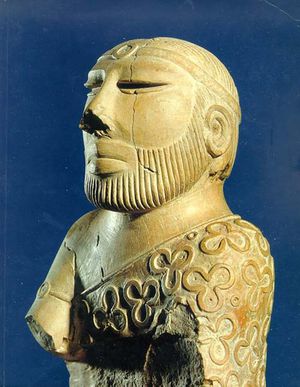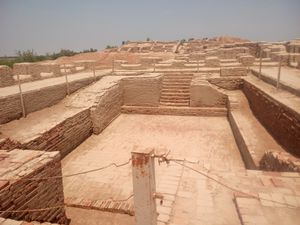How Extensive Was the Indus Valley Civilization’s Influence
The Indus Valley Civilization – also sometimes referred to as the “Harappan Civilization” for one of its primary cities – was one of the world’s first civilizations, along with Egypt and Mesopotamia. Beginning about 3200 BC, groups of people in the Indus River Valley of what are today northwest India and southeast Pakistan began to form cities, eventually coalescing into a defined culture and reaching all the hallmarks of civilization.
Although the Indus Valley people developed writing, the script remains undeciphered so details about their civilization remain enigmatic. Modern scholars do not know if the civilization was ever under the rule of one king or ruler as ancient Egypt and as ancient Mesopotamia was at different times, and details about the Indus Valley religion, social structure, and economy also remain a mystery. With that said, archaeologists have discovered that that the Indus people had well-built and organized cities and that they developed intricate trade networks throughout south Asia and into the Near East.
By the period modern scholars know as the Mature Harappan Phase (ca. 2600-1900 BC), the entire Indus Valley was part of complex system. Archaeological evidence shows that the people of the Indus Valley exerted great cultural and economic influence not just around the Indus River, but throughout what are today Pakistan and India. Contemporary texts from Mesopotamia also demonstrate that the Indus Valley/Harappan people also had trade ties with the Near East and may have had some influence on that region.
The Indus Valley/Harappan Civilization
The Indus Valley Civilization began around the modern sites of Mohenjo-Daro, Harappa, Ganweriwala, and Kalibangan, among other places, beginning around 3200 BC. The first phase of the civilization is known as the “Early Harappan phase” and lasted until about 2600 BC. This era of Indus Valley Civilization is known as an “era of regionalization,” were the various important sites in the Valley developed somewhat independently, but a clear Harappan cultural identity was emerging as evidenced by unique pottery. Because of this, some scholars view the Early Harappan phase as a transition from the Neolithic Period to the Mature Harappan phase. [1]
The “Mature Harappan phase” of the Indus Valley Civilization took place from about 2600 BC until around 1900 BC. Although there was continuity of Indus Valley cultural traditions from the Early to the Mature Harappan phases, many of the unique hallmarks of the civilization were established after 2600 BC. All of the larger cities and many of the smaller villages featured street layouts according to the cardinal directions, which suggests that the cities were built with some type of advanced astronomical knowledge. [2] Advanced drainage systems and elaborate baths were also a common feature in the larger cities and the three largest cities – Mohenjo-Daro, Harappa, and Ganwierwala – are believed to have had 30,000 to 50,000 people, possibly being capitals of regional kingdoms. [3]
There is no question that it took an incredible amount of technical and political sophistication to build the cities of the Indus Valley, but unfortunately, the inability to read the Indus texts has left scholars guessing as to the type of government that existed. Since there are no known kings or dynasties that ruled in the ancient Indus Valley, some archaeologists believe it was a “stateless” civilization. [4] The Indus Valley Civilization may have lacked a central government and existed more like a collection of city-states as with the Maya in Meso-America or during some periods in Mesopotamia, but the collection of cities wielded an immense amount of influence culturally in south Asia and economically in the Near East.
The Indus Valley’s Cultural Influence
Although the Indus Valley mysteriously collapsed in the early second millennium BC, many scholars believe that some of its cultural traditions were continued by the later peoples and kingdoms of India. Ritual bathing was an important aspect of Indus Valley culture that may have been one of the many features of Harappan religion that were incorporated into the later Vedic and Hindu religions of India. [5] The many seal impressions excavated from Indus Valley sites also indicate religious influences that later Indians possibly adopted. One of those seals, known today as the “Shiva seal,” depicts a human figure wearing an elaborate headdress seated in a yogic position.
Although not all scholars are convinced that the figure represents Shiva or that it is even religious in nature, those who believe it is and that it represents a Harappan religious influence on later Indian religion point to other examples in the Indus Valley that may indicate origins for some Vedic traditions. Structures discovered at the site of Kalibangan have been interpreted by some as being fire altars, which would predate those used by the Aryans at a much later period. [6] Unfortunately, in the absence of a written text, it is impossible to confirm how much, if any, religious influence the Harappans had on later Indian religions.
The Harappans were the first people to develop writing on the Indian subcontinent. Archaeologists have discovered more than 4200 inscribed objects in the Indus Valley, most from Mohenjo-Daro and Harappa. The Indus writing system employed 419 signs, but unfortunately, even after several valiant attempts to link the writing and language to known languages scholars are still left wondering as to its origins. [7] Some scholars have attempted to link the later Sanskrit language or Dravidian languages to the undeciphered Indus script, [8] which if proven would confirm that that Indus people had an even greater influence on later Indian culture than previously believed. Still, even if the Indus language and script is discovered to not be related to any of the later Indian languages – Indo-European or Dravidian – it was the first written language on the subcontinent and may have influenced the concept of later writing in India.
The Indus Valley and International Connections
Geographically speaking, the Indus Valley Civilization’s greatest influence can be seen in far away Mesopotamia. The Mature Harappan phase of the Indus Valley Civilization coincided with the Akkadian and Amorite dynasties in Mesopotamia and the Middle Kingdom in Egypt. [9] Several cuneiform inscriptions in the Akkadian language describe how King Sargon of Akkad (ruled ca. 2296-2240 BC) received ships from the land of Meluhha, which modern scholarly consensus places in the Indus Valley. The interaction between the two civilizations became so common that Akkadian texts document Indus interpreters in Mesopotamia. [10] A cuneiform text from the city of Lagash from the same period demonstrates that the Indus Valley people were also involved in trade with that Mesopotamian city.
“When he (Gudea) was building the temple of Ningirsu, Ningirsu, his beloved king, opened up for him (all) the (trade) routs from the Upper to the Lower Sea. . . He imported (lit.: brought out) esi wood from the mountains of Meluhha and built . . . He imported nir stone and made it into a mace with three lion-heads; from the Hahhum mountains, he imported gold in dust-form and mounted with it the mace with the three lion-heads. From the mountains of Meluhha, he imported gold in dust-form and made (out of it) a container (for the mace).” [11]
Other texts from Mesopotamia also mention how red stone from the Indus Valley was sent to Mesopotamia, proving that the two civilizations had deep economic ties. Archaeological evidence from the Indus Valley, though, indicates that the connections between the regions may have been even earlier and stronger than previously thought. Excavations of the cemeteries at Harappa and examinations of the human remains indicates that the Harappan people may have been involved in an economic and cultural sphere that was centered in the Iranian Plateau. [12] The human remains from the Harappa cemeteries were compared with other samples from Bronze Age Near Eastern peoples and showed that the Harappans had some biological affinities to Mesopotamian peoples. This discovery seemed to confirm for some scholars the unproven theory that the Sumerians were originally from India, while other scholars believe it may show a link between the Elamites and the Dravidians, although it is not known if the Harappans actually were a Dravidian speaking people. [13]
Excavations at Harappa have also uncovered standardized weights, etched carnelian beads, and different pottery that suggest a connection between the Indus Valley and the people of the Bronze Age Persian Gulf. [14] When all of the archaeological evidence from the Indus Valley is considered along with the archaeological and textual evidence from Mesopotamia, then it is clear that the Harappans exerted an influence that went well beyond the marches of their civilization.
Conclusion
The Indus Valley Civilization has the distinction of being one of the world’s true primary civilizations, but it is also perhaps the most enigmatic. Unlike ancient Egypt and Mesopotamia, the Indus Valley was unknown until the nineteenth century and even now it remains somewhat elusive due to its so far undeciphered script. Despite the obstacles of uncovering the Indus Valley Civilization, archaeologists have been able to make great headway over the last several decades and have revealed a civilization that was very influential not only in south Asia but throughout the Bronze Age Near East. Harappan merchants and traders established trade links with Mesopotamia and in the process, there also appears to have been significant genetic and cultural interaction as well. All of these factors ensured that the Harappan people’s influence would continue long after their cities were gone.
References
- ↑ Avari, Burjor. India: The Ancient Past: A History of the Indian Sub-continent from c. 7000 BC to AD 1200. (London: Routledge, 2007), pgs. 29-32
- ↑ Kenoyer, Jonathan Mark. Ancient Cities of the Indus Valley Civilization. (Oxford: Oxford University Press, 1999), p. 52
- ↑ Haywood, John. The Historical Atlas of Ancient Civilizations. (London: Penguin, 2005), p. 76
- ↑ Possehl, Gregory L. The Indus Civilization: A Contemporary Perspective. (Lanham, Maryland: Altamira Press, 2007), p. 6
- ↑ Avari, p. 48
- ↑ Bryant, Edwin. The Quest for the Origins of Vedic Culture: The Indo-Aryan Migration Debate. (Oxford: Oxford University Press, 2001), pgs. 160-5
- ↑ Avari, pgs, 50-51
- ↑ Bryant, pgs. 179-182
- ↑ Kenoyer, p. 17
- ↑ Kuhrt, Amélie. The Ancient Near East: c. 3000-330 BC. (London: Routledge, 2010), p. 53
- ↑ Pritchard, James B. Ancient Near Eastern Texts Relating to the Old Testament. Third Edition. (Princeton, New Jersey: Princeton University Press, 1992), p. 53
- ↑ Hemphill, Brian E., John R. Lukacs, and K. A. R. Kennedy. “Biological Adaptations and Affinities of Bronze Age Harappans.” In Harappa Excavations 1986-1990: A Multidisciplinary Approach to Third Millennium Urbanism. Edited by Richard W. Meadow. (Madison, Wisconsin: Prehistory Press, 1991), p. 139
- ↑ Hemphill et. al., pgs. 173-4
- ↑ Wright, Rita P. “Patterns of Technology and the Organization of Production at Harappa.” In Harappa Excavations 1986-1990: A Multidisciplinary Approach to Third Millennium Urbanism. Edited by Richard W. Meadow. (Madison, Wisconsin: Prehistory Press, 1991), p. 72


